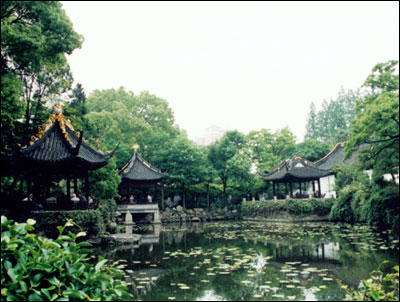Qushui Garden Release time:November 28,2023

Built in the 10th year of Qianlong Reign of Qing Dynasty (1745), the Qushui Garden has a history of over 200 years and one of the five ancient gardens in Shanghai. Qushui Garden is located in the Qing Pu District and sitting alongside the city river. It used to be subordinate to Chenghuang Temple and originally consisted of Intelligence Hall, Moon Room, Songs Building, Sunrise Pavilion and added Bank Boat, Sunset Building and Harmony Hall. In the 49th year of Qianlong Reign (1784) when Wang Xiyi was Magistrate of Qing Pu, Lotus Pool, Artificial Hill, Qushui Causeway, Green Pavilion, Brocade Washing Rock, Rain Bridge, Sunrise Pavilion, Flora Hall and the garden was named "Ling Garden". In the third year of Xiqing Reign of Qing Dynasty (1798), the Scholar of Jiangsu Province Liu Yunfang was invited by the Magistrate Yang Dongping to visit the garden. Seeing the winding water in the garden, he changed the name to Qushui. Qushui Garden contains 24 scenic spots, each stone, water and pavilion presents its own fun.
The Harmony Hall is the center of Qushui Garden. In the center above the hall, there is an inscribed board written by Li Hongzhang of the Qing Dynasty and on the east and west walls hang four scripts and paintings that are five feet long each. The hall is grand and spacious, with a small yard in the front surrounded by white walls and a flower terrace where such plants as privet, sweet osmanthus, Yulan Magmolia and white bark pine are planted. Coming out from the Chinese banana gate at the east side of Harmony Hall is the Flora Hall. There were 12 statues of floras and February 15th of each year on the lunar calendar is the day to offer sacrifices to the floras.
Qushui Garden is known for its elegance and grace. The buildings reserve the garden features with the halls surrounded by black brick walls and gates that are arch, round or square. On the top of pavilions, there are gourd-like or urn-shaped decorations. Plants are dominated by bamboos and there are black bamboo, bambusa multiplex, hairy bamboo and fernleaf bamboo, etc. The paths are stone, winding and intricate. The stones present various shapes, some like a sheep while some like a Ru Yi. The layout is delicate and implicit, presenting an artistic characteristic.
Address: No. 14, Gong Yuan Road, Qing Pu Town
Traffic: Hu-Qing Line, Qingpu No. 9 Bus, Qingpu No. 3 Bus
Tel.: 021-59728861
Ticket price: 5 yuan/person